
Super Mario World 2: Yoshi's Island is a 1995 platform game developed and published by Nintendo for the Super Nintendo Entertainment System (SNES). It is the sequel follow-up to Super Mario World. The player controls Yoshi, a friendly dinosaur, on a quest to reunite baby Mario with his brother Luigi, who has been kidnapped by Kamek. As a Super Mario series platformer, Yoshi runs and jumps to reach the end of the level while solving puzzles and collecting items with Mario's help. The game has a hand-drawn aesthetic and was the first in the franchise to have Yoshi as its main character, where it introduces his signature flutter jump and egg spawning abilities.

Wario Land 4 is a 2001 platform game developed by Nintendo and released for the Game Boy Advance. Wario has to gather four treasures to unlock a pyramid and save Princess Shokora from the Golden Diva.

Wario World is a platform video game developed by Treasure and published by Nintendo for the GameCube. Part of the Wario series, it was released in Europe, North America and Australia in 2003 and Japan in 2004. The game's plot centers on Wario and his quest to regain his treasure and his castle from the evil gem, Black Jewel.

Kirby's Adventure is a 1993 platform game developed by HAL Laboratory and published by Nintendo for the Nintendo Entertainment System (NES). It is the second game in the Kirby series after Kirby's Dream Land (1992) on the Game Boy and the first to include the Copy Ability, which allows the main character Kirby to gain new powers by eating certain enemies. The game centers around Kirby traveling across Dream Land to repair the Star Rod after King Dedede breaks it apart and gives the pieces to his minions.

Pokémon Pinball: Ruby & Sapphire is a 2003 pinball game developed by Jupiter and published by The Pokémon Company and Nintendo for the Game Boy Advance handheld game console. It was first revealed at E3 2003. The North American release was done to coincide with the fifth anniversary of the North American release of Pokémon Red and Blue. It is based on Pokémon Ruby and Sapphire, and is a sequel to Pokémon Pinball for the Game Boy Color. In some ways, it plays like a traditional pinball game, where the objective is to get a high score by keeping the ball in play as long as possible and hitting bumpers. In keeping with the theme of Pokémon, it features Pokémon collection, where while the players play pinball, they must also capture the eponymous creatures.
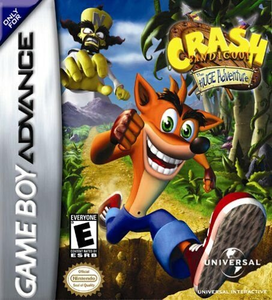
Crash Bandicoot: The Huge Adventure is a 2002 platform game developed by Vicarious Visions and published by Universal Interactive for the Game Boy Advance. It is the seventh installment in the Crash Bandicoot video game series, the first Crash Bandicoot game not to be released on a PlayStation console, and the first Crash Bandicoot game to be released on a handheld console. The game's story centers on a plot to shrink the Earth by the main antagonist, Doctor Neo Cortex, through the use of a gigantic weapon named the "Planetary Minimizer". The protagonist of the story, Crash Bandicoot, must gather Crystals in order to power a device that will return the Earth to its proper size, defeating Doctor Cortex and his minions along the way.

Banjo-Kazooie: Grunty's Revenge is a 2003 platform game developed by Rare for Nintendo's Game Boy Advance (GBA). It is the third instalment in the Banjo-Kazooie series and takes place between the events of the Nintendo 64 (N64) games Banjo-Kazooie (1998) and Banjo-Tooie (2000). In Grunty's Revenge, the evil witch Gruntilda travels back in time to prevent the events of Banjo-Kazooie from happening, and the bear Banjo and his bird friend Kazooie set out to stop her. Grunty's Revenge retains the focus on collecting items and most of the other game mechanics from its predecessors, but is presented in 2D rather than 3D. Aside from the main game, players can also access minigames such as fishing and target shooting.

The Sims Bustin' Out is a video game developed by Maxis and published by Electronic Arts in 2003 for the PlayStation 2, Xbox, GameCube, Game Boy Advance, and in 2004 for the N-Gage. It is the second title in The Sims console series and the first title not concurrently released on Windows PC.
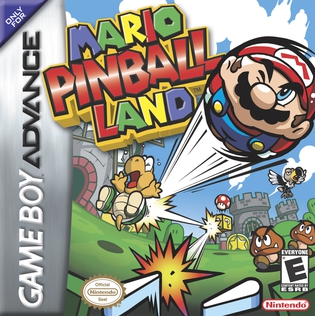
Mario Pinball Land, known in Europe and Japan as Super Mario Ball, is a pinball video game developed by Fuse Games and published by Nintendo for the Game Boy Advance, released in 2004. It is the ninth Mario game for the Game Boy Advance and is considered a spin-off into the Super Mario series of games. The game was later re-released for the Wii U Virtual Console.

Tails Adventure is a platform game developed by Aspect and published by Sega in 1995 for the Game Gear. The game stars Tails from the Sonic the Hedgehog series in a solo adventure, as he collects an array of items to help him explore Cocoa Island and defeat the enemies inhabiting it. The gameplay is more slow-paced than other Sonic games, with Tails only capable of walking and flying at a moderate speed. The stages are explored in a non-linear fashion, with newly collected items opening up pathways in previous areas.

Klonoa: Empire of Dreams is a 2001 platform video game published by Namco for the Game Boy Advance. Falling somewhere between Klonoa: Door to Phantomile and Klonoa 2: Lunatea's Veil, Empire of Dreams is a two-dimensional adventure game with puzzle elements that takes place in the new realm in the Klonoa series, the Empire of Jillius.
Disney's Magical Quest is a Disney platform game trilogy released by Capcom. The games star Mickey Mouse and either Minnie Mouse or Donald Duck, who must defeat Pete. The gameplay is similar amongst all games in the series: the player must move as in a typical platform game, defeating enemies either by jumping on them or by grabbing and throwing blocks at them.

Bionicle Heroes is a 2006 video game published by Eidos Interactive and TT Games Publishing and based on Lego's Bionicle line of constructible action figures. The game was released in November 2006 on PlayStation 2, Xbox 360, GameCube, Microsoft Windows, Game Boy Advance, and Nintendo DS; a Nintendo Wii version was later released in April 2007. The home console and PC versions were developed by Traveller's Tales, while Amaze Entertainment developed the handheld versions. A version of the game for mobile phones, developed by Universomo, was also released. The home console and PC versions of the game are third-person shooters, while the Game Boy Advance version is a run 'n' gun shoot 'em up and the Nintendo DS version is a first-person shooter. The story of Bionicle Heroes, where the player seeks to liberate the island of Voya Nui and its inhabitants from the villainous Piraka, is not canon to the official Bionicle story.

The Legend of Zelda: A Link to the Past and Four Swords is a compilation of two action-adventure games co-developed by Nintendo R&D2 and Capcom and published by Nintendo for the Game Boy Advance. The game was released in December 2002 in North America and in March 2003 in Japan and Europe. The cartridge contains a modified port of A Link to the Past, originally released for the Super Nintendo Entertainment System in 1991, and an original multiplayer-only game titled Four Swords, which serves as the 9th installment in The Legend of Zelda series.
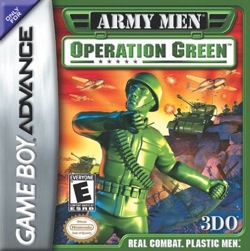
Army Men: Operation Green is a top-down shooter video game developed by Pocket Studios and published by The 3DO Company exclusively for the Game Boy Advance. It was released in North America on December 3, 2001 and in Europe on March 15, 2002. It is part of the Army Men series of video games created by The 3DO Company, which is based on army men toys. It is the second game in the series for the Game Boy Advance, after the 2001 release, Army Men Advance.

Crash Bandicoot Purple: Ripto's Rampage and Spyro Orange: The Cortex Conspiracy are two platform games published by Vivendi Universal Games. The games are developed by Vicarious Visions for the Game Boy Advance. They were released in North America on June 3, 2004, and in Europe on June 25, 2004 under the names Crash Bandicoot Fusion and Spyro Fusion.
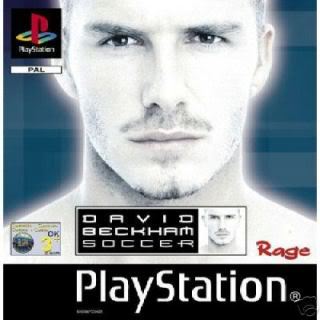
David Beckham Soccer is a football video game for PlayStation, PlayStation 2 and Xbox, Game Boy Advance and Game Boy Color. All formats were developed and published by Rage Software, apart from the Game Boy versions which were developed by Majesco Entertainment And Yoyo Entertainment.

Banjo-Pilot is a 2005 kart racing video game for the Game Boy Advance (GBA) and the fourth instalment in Rare's Banjo-Kazooie series. It plays similarly to the Mario Kart series by Nintendo: the player races one of nine playable characters around tracks, attacking other racers with bullets and collecting power-ups. The game features a number of single-player and multiplayer modes, such as time attack and item hunts. Unlike other kart racing games, characters control airplanes instead of go-karts.
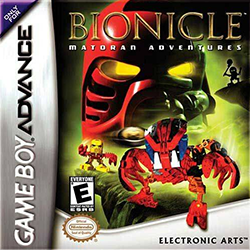
Bionicle: Matoran Adventures is a 2002 platform game based on Lego's Bionicle line of constructible action figures. It was developed by Argonaut Games and co-published by Electronic Arts and Lego Interactive for the Game Boy Advance. The player controls Matoran and Turaga characters, who must work together to repel the invasion of Bohrok, insect-like robots that threaten the island of Mata Nui.

Disney's Lilo & Stitch: Trouble in Paradise is a 2002 action-platform video game developed by Blitz Games for PlayStation and Microsoft Windows. The game is a tie-in to and based on the Walt Disney Feature Animation film, Lilo & Stitch. The PlayStation version was published by Sony Computer Entertainment, while the Windows version was published by Disney Interactive Studios.




















